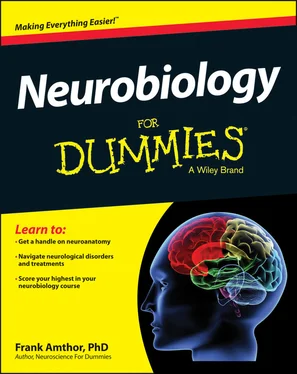Feeling, smelling, and tasting
Skin sensation is composed of a group of different types of sensory capabilities controlled by different receptors in the skin and a few other places, such as the mouth and trachea. Mechanoreceptors detect shallow and deep pressure, applied constantly or intermittently. Cold and warm temperature receptors respond to skin temperatures below or above body temperature. Pain receptors respond to mechanical or chemical inputs likely to cause injury.
The sense of smell is mediated by several thousand different receptor types in the olfactory organ in the roof of the nasal cavity. Evolutionary evidence suggests that some of the earliest neocortex in mammals may have been devoted to sorting out and identifying what produced the smells detected by the olfactory receptors.
 A dog has about one billion olfactory receptors, a number comparable to the total number of neurons in its entire brain. I’m sure my dogs sniffing around the yard every morning know what was there last night, and probably when, and probably what each critter did, from the smells left over.
A dog has about one billion olfactory receptors, a number comparable to the total number of neurons in its entire brain. I’m sure my dogs sniffing around the yard every morning know what was there last night, and probably when, and probably what each critter did, from the smells left over.
The olfactory system is unique in being divided between a pathway that projects (although indirectly) through the thalamus, of which we are aware, and a pathway that is non-thalamic, which influences our behavior, but of which we are not directly aware.
The sense of taste is mediated by salt, sweet, sour, and bitter receptors located mostly on the tongue. Some taste researchers also include the MSG taste, umami, as a fundamental taste.
Learning and memory: Circuits and plasticity
A behavioral hallmark of mammals is they can change their behavior through learning. High-level learning involves a neural representation of both an event and its context. Much of this representation occurs in the lateral prefrontal cortex as what is called working memory. This area of cortex has extensive connections with the hippocampus, where modifiable synapses containing NMDA receptors abound. Reciprocal connections between the hippocampus and the neocortical areas that originally represented that which is to be remembered instantiate the memory “trace” back in those areas of the neocortex.
 The finding that the neocortex represents both original sensory input and its memory has profound implications for understanding what memory is. Many neuroscientists now believe that memory is intrinsically reconstructive — a hallucination, if you will. This is a very different metaphor from the token look up and address model taken from computer science. One important aspect of the reconstructive aspect of memory is that the act of reconstruction can distort the memory. Suggestions, guesses, and events after the memory can affect the reconstruction such that they become part of, and indistinguishable from, subsequent reconstructions.
The finding that the neocortex represents both original sensory input and its memory has profound implications for understanding what memory is. Many neuroscientists now believe that memory is intrinsically reconstructive — a hallucination, if you will. This is a very different metaphor from the token look up and address model taken from computer science. One important aspect of the reconstructive aspect of memory is that the act of reconstruction can distort the memory. Suggestions, guesses, and events after the memory can affect the reconstruction such that they become part of, and indistinguishable from, subsequent reconstructions.
The neurobiology of memory depends both on modifiable synaptic weights, such as with NMDA receptors in hippocampus and cortex, and the creation of new neurons in memory areas such as the hippocampus. The discovery of the birth of neurons in the adult hippocampus overturns the old idea of zero neurogenesis in the adult brain. Some senile dementia and even depression appear to be associated with failure of this mechanism.
The frontal lobes and executive brain
The frontal lobes are responsible for planning and executing behavior. Generally speaking, the output of the frontal lobe is in its most posterior portion, the primary motor cortex. Neurons in primary motor cortex send their axons down the spinal cord (or out some cranial nerves) to drive motor neurons that cause muscles throughout the body to contract.
Anterior to the primary motor cortex are the supplementary motor area and premotor cortex that organize the firing of groups of muscles. Anterior to those areas are the frontal eye fields and other areas called prefrontal cortex (even though they are in the frontal lobe) that are involved in more abstract aspects of planning.
It is generally held that there is relative expansion of the frontal lobe compared to the rest of the brain in humans compared to other primates, and primates compared to other mammals. Some exceptional non-primate mammals such as the echidna have large frontal lobes, however. This has led to debate among neuroscientists about whether these frontal areas are really homologous across mammalian species. Whatever the result of that debate, we know that damage to prefrontal cortex in humans produces distinctive cognitive deficits such as impulsive behavior and profound changes in affect.
Language, emotions, lateralization, and thought
True grammatically ordered language distinguishes humans from all other species on earth. Recent evidence has suggested an important role for a gene called FOXP2 in generating language capability, although how this gene changes the brain to allow language isn’t clear.
The human brain does not contain any distinct anatomical structures or types of neurons associated with language. The human brain areas most crucial for language, Wernicke’s and Broca’s areas on the left side (in most humans), have homologous areas in other primates, but these areas do not support language. Yet all normal human infants learn, without any explicit instruction, whatever language to which they are exposed, but other animals do not learn grammatical, word-order based language despite extensive instruction.
The capacity for learning language is built in, but neuroscience does not now know how. One clue may be brain lateralization, however. Left- versus right-side specialization for some types of audio processing and production exists in other mammals, and even some birds, but is nowhere near as extensive as in humans.
 A similar association exists with right-hand dominance, driven by the left side of the brain, which is more extensive in humans than any other animal. Chimpanzees, for example, may be relatively right- or left-hand preferring, but most have no overall tendency to be strongly right-handed or left-handed, the way humans do.
A similar association exists with right-hand dominance, driven by the left side of the brain, which is more extensive in humans than any other animal. Chimpanzees, for example, may be relatively right- or left-hand preferring, but most have no overall tendency to be strongly right-handed or left-handed, the way humans do.
Neuroscience’s view of emotions has changed markedly in the last decades. Earlier views regarded emotions as leftovers from our evolution from non-rational species. Star Trek ’s Mr. Spock could be taken as a model of a superior, more evolved humanoid. However, we now know that emotions are a means of nonverbal communication within our brains. Hunches and anxiety in certain situations are signs of danger and the need to be cautious.
 We see the usefulness of this nonverbal information in people with damage to the orbitofrontal cortex or amygdala. They may gamble recklessly or commit social faux pas because they lack internal feelings about the mistakes they’re making.
We see the usefulness of this nonverbal information in people with damage to the orbitofrontal cortex or amygdala. They may gamble recklessly or commit social faux pas because they lack internal feelings about the mistakes they’re making.
Developmental, Neurological, and Mental Disorders and Treatments
One of the most important reasons to understand neurobiology is to understand mental disorders and treatments. The good news is that great progress is being made in this field now. We know the genetic bases of many developmental disorders, such as Fragile X and William’s syndrome. The bad news is that many disorders remain that we do not know about, and, even among disorders with known genetics, how the gene alteration produces the disorder, and what to do about it, are not clear. Chapters 15through 18discuss the background and current treatment approaches (if any) of many common neurological disorders.
Читать дальше

 A dog has about one billion olfactory receptors, a number comparable to the total number of neurons in its entire brain. I’m sure my dogs sniffing around the yard every morning know what was there last night, and probably when, and probably what each critter did, from the smells left over.
A dog has about one billion olfactory receptors, a number comparable to the total number of neurons in its entire brain. I’m sure my dogs sniffing around the yard every morning know what was there last night, and probably when, and probably what each critter did, from the smells left over.










